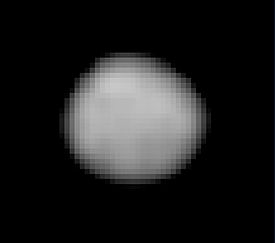2 Pallas

An ultraviolet image of Pallas showing its flattened shape, taken by the Hubble Space Telescope in 2007
|
|
| Discovery | |
|---|---|
| Discovered by | Heinrich Wilhelm Olbers |
| Discovery date | 28 March 1802 |
| Designations | |
| Pronunciation | /ˈpæləs/ PAL-əs |
|
Named after
|
Pallas Athena |
|
asteroid belt (Pallas family) |
|
| Adjectives | Palladian /pæˈleɪdiən/ |
| Orbital characteristics | |
| Epoch 2014-Dec-09 (JD 2457000.5) | |
| Aphelion | 3.412605509 AU (510.4 Gm) |
| Perihelion | 2.13060671 AU (318.9 Gm) |
| 2.77160611 AU (414.7 Gm) | |
| Eccentricity | 0.23127363 |
| 4.614296176 yr (1685.371678 d) | |
|
Average orbital speed
|
17.65 km/s |
| 78.228704° | |
| Inclination | 34.840998° to ecliptic 34.21° to invariable plane |
| 173.096248° | |
| 309.930328° | |
| Satellites | none |
| Proper orbital elements | |
|
Proper semi-major axis
|
2.7709176 AU |
|
Proper eccentricity
|
0.2812580 |
|
Proper inclination
|
33.1988686° |
|
Proper mean motion
|
78.041654 deg / yr |
|
Proper orbital period
|
4.61292 yr (1684.869 d) |
|
Precession of perihelion
|
−1.335344 arcsec / yr |
|
Precession of the ascending node
|
−46.393342 arcsec / yr |
| Physical characteristics | |
| Dimensions |
550±8 × 516±6 × 476±6 km 512±6 km (mean) |
| (8.3±0.2)×105 km2 | |
| Volume | (7.1±0.3)×107 km3 |
| Mass | (2.11±0.26)×1020 kg |
|
Mean density
|
3.0±0.5 g/cm3 |
| ≈ 0.21 m/s² (average) 0.022 g |
|
| ≈ 0.33 km/s | |
|
7.8132214±0.000002 h (0.32555089±0.00000008 d) |
|
|
Equatorial rotation velocity
|
65 m/s |
| 84°±5° | |
| Albedo | 0.159 (geometric) |
| Temperature | ≈ 164 K max: ≈ 265 K (−8 °C) |
|
Spectral type
|
B-type asteroid |
| 6.49 to 10.65 | |
| 4.13 | |
| 0.629″ to 0.171″ | |
Pallas, minor-planet designation 2 Pallas, is the second asteroid to have been discovered (after Ceres), and it is one of the largest asteroids in the Solar System. With an estimated 7% of the mass of the asteroid belt, it is the third-most-massive asteroid, being 10–30% less massive than Vesta. It is 512 kilometers (318 mi) in diameter, somewhat smaller than Vesta. It is likely a remnant protoplanet.
When Pallas was discovered by the German astronomer Heinrich Wilhelm Matthäus Olbers on 28 March 1802, it was counted as a planet, as were other asteroids in the early 19th century. The discovery of many more asteroids after 1845 eventually led to their reclassification.
Pallas's surface is most likely composed of a silicate material; its spectrum and estimated density resemble carbonaceous chondrite meteorites. With an orbital inclination of 34.8°, Pallas's orbit is unusually highly inclined to the plane of the asteroid belt, and its orbital eccentricity is nearly as large as that of Pluto, making Pallas relatively inaccessible to spacecraft.
It was formerly considered a possible dwarf planet due to its size, but it is no longer considered such due to having significant departures from an ellipsoid.
On the night of Apr 5, 1779 Charles Messier recorded Pallas on a star chart he used to track the path of a comet (now known as C/1779 A1 (Bode)) that he observed in the Spring of 1779, but apparently assumed it was nothing more than a star.
...
Wikipedia
